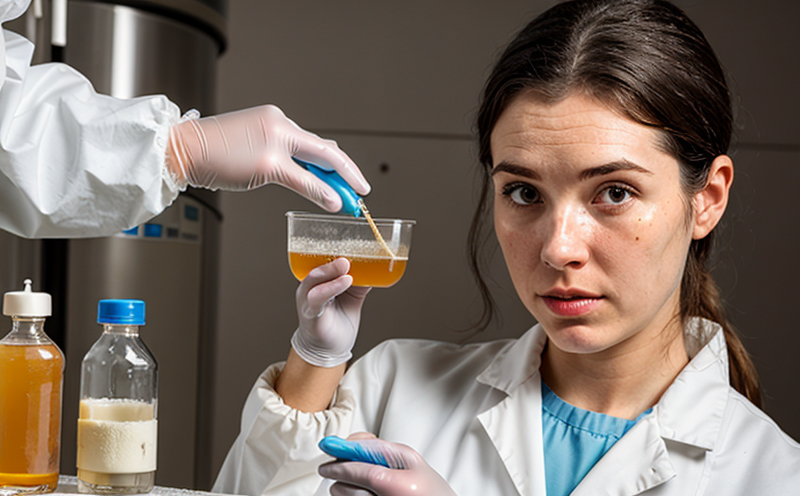FDA BAM Chapter 18 Yeast and Mold Identification in Foods
The FDA Bacteriological Analytical Manual (BAM) Chapter 18 provides a comprehensive guide for the identification of yeast and mold species in food products. This chapter is critical for ensuring the safety and quality of foodstuffs, as it mandates rigorous testing to identify potentially harmful microorganisms that can contaminate products during processing or storage.
At Eurolab, we specialize in FDA BAM Chapter 18 compliance, offering expert services tailored to meet the stringent requirements outlined in this chapter. Our team of microbiologists and chemists is equipped with state-of-the-art facilities and advanced instrumentation to ensure accurate identification and quantification of yeast and mold species in various food matrices.
The testing process begins with thorough sample preparation, which involves homogenizing the food matrix to release viable cells for analysis. Following this step, we employ a combination of traditional microbiological methods and modern molecular techniques such as PCR (Polymerase Chain Reaction) and MALDI-TOF MS (Matrix-Assisted Laser Desorption/Ionization-Time of Flight Mass Spectrometry), to identify the specific species of yeast and mold present in the sample.
The identification process is further enhanced by our extensive reference library, which includes data on over 1000 strains of microorganisms. This ensures that we can accurately differentiate between closely related species, providing reliable results even for complex samples.
- Traditional microbiological methods: These include colony counting and microscopic examination to identify morphological characteristics.
- Molecular techniques: PCR amplification followed by sequencing is used to confirm the identity of the organisms detected.
The FDA BAM Chapter 18 also requires quantification of viable yeast and mold cells. Our laboratory uses calibrated equipment such as hemocytometers or flow cytometry for precise counts, ensuring that even low levels of contamination are detectable. Once the identification and quantification steps are completed, our reports provide detailed information on all detected species along with their concentration levels.
Our commitment to FDA BAM Chapter 18 compliance extends beyond mere testing; it encompasses a proactive approach towards maintaining food safety standards. By adhering strictly to this chapter’s guidelines, we help our clients meet regulatory requirements and build consumer trust through transparent labeling practices regarding potential allergens or contaminants from yeast and mold.
Environmental and Sustainability Contributions:
- We contribute to reducing waste by optimizing sample collection methods which minimize unnecessary disposal.
- Our efficient testing processes save resources like water and electricity used in laboratory operations.
- By ensuring accurate identification and quantification of microorganisms, we prevent contamination incidents that could lead to increased resource consumption during reprocessing or scrapping affected batches.
In conclusion, Eurolab’s FDA BAM Chapter 18 yeast and mold identification service is designed to meet the highest standards set forth by regulatory bodies worldwide. With our expertise and cutting-edge technology, we ensure that your products remain safe and compliant with all relevant food safety regulations.
Eurolab Advantages
At Eurolab, we pride ourselves on delivering exceptional service backed by decades of experience in the field of microbiological testing. Our advantages include:
- Expertise and Experience: Our team consists of highly skilled professionals with extensive knowledge about FDA BAM Chapter 18 requirements.
- State-of-the-Art Facilities: Equipped with advanced instrumentation, our laboratory ensures accurate and reliable results every time.
- Comprehensive Reference Library: Access to over 1000 strains of microorganisms allows us to identify even the most complex samples accurately.
- Proactive Approach: We go beyond mere testing by offering advice on how to prevent future contamination issues, helping you maintain consistent product quality.
We understand that time is money in today’s competitive market. That’s why we strive to deliver rapid turnaround times without compromising on the accuracy of our results. Our commitment to excellence has earned us a reputation as one of the leading laboratories for FDA BAM Chapter 18 compliance.
Why Choose This Test
Selecting the right testing method is crucial when dealing with issues related to yeast and mold in food products. Here are some reasons why choosing our FDA BAM Chapter 18 yeast and mold identification service makes sense:
- Rigorous Compliance: Ensures strict adherence to regulatory guidelines, safeguarding your brand reputation.
- Accurate Identification: Utilizing both traditional methods and advanced molecular techniques guarantees precise detection of all relevant species.
- Quantitative Results: Provides detailed counts of viable yeast and mold cells, aiding in effective quality control measures.
- Confidence in Reporting: Our comprehensive reports offer clear insights into the presence and concentration levels of microorganisms found within your product batches.
Incorporating FDA BAM Chapter 18 testing into your quality assurance program helps establish a culture of continuous improvement, ensuring that every batch produced meets or exceeds regulatory standards. This proactive approach not only protects consumers but also enhances brand loyalty and market trust.





